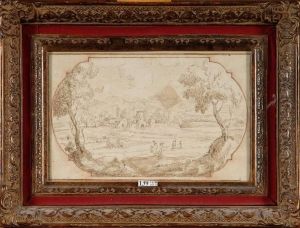Remigio Canta Gallina Paintings
Remigio Cantagallina was an Italian artist born in 1582 in Sansepolcro, Tuscany, known for his detailed etchings and drawings of landscapes and cityscapes. He was a contemporary of the Baroque period, which was characterised by its dramatic style and clarity. Cantagallina's work, however, often retained elements of the earlier Mannerist style, with its complex compositions and emphasis on figures.
Cantagallina was influenced by the works of other artists from his hometown, such as Piero della Francesca, and he often incorporated elements of their style into his own. He was particularly known for his skill in etching, a technique that was becoming increasingly popular at the time for its ability to reproduce artworks.
He traveled extensively throughout Italy and Europe, which greatly impacted his artistic development. His journeys allowed him to study under different masters and to be exposed to a variety of styles, which he then melded into his own unique approach. His travels through Belgium and the Netherlands in 1612–1613 were particularly influential. During this time, he produced numerous drawings of cities and landscapes, which not only served as souvenirs but also as studies and reference materials for his later etchings. These works are valuable historical records today because they accurately depict many locations as they appeared in the early 17th century.
Cantagallina's works were collected by many prominent figures of his time, and his influence extended to other artists, particularly in the realm of etching and landscape drawing. While he may not be as widely recognized today as some of his contemporaries, his contribution to the art of etching and his role in documenting the landscapes of his era make him a notable figure in the history of art.
Remigio Cantagallina died in 1633, leaving behind a legacy as a master etcher and draughtsman whose works provide a window into the world of the early 17th century. His drawings and etchings continue to be studied and appreciated for their technical skill and historical value.
